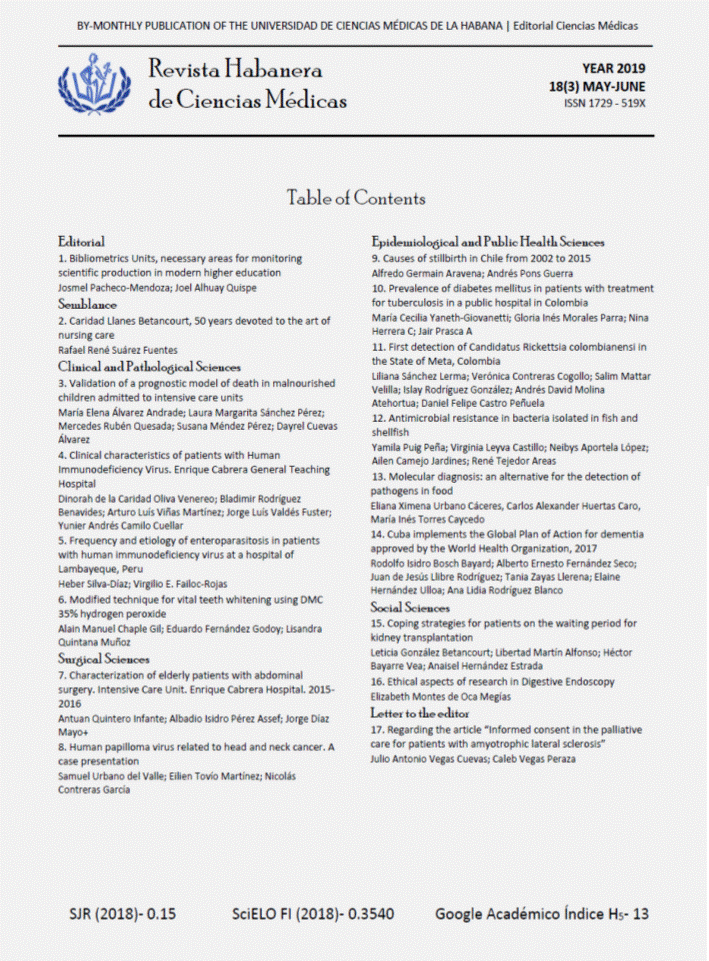First detection of Candidatus Rickettsia colombianensi in the State of Meta, Colombia
Keywords:
Rickettsiosis, IFI, PCR, Candidatus Rickettsia colombianensi, Garrapatas, ColombiaAbstract
Introduction: Rickettsia is a genus of Gram-negative obligate intracellular bacteria that cause several epidemics around the world and are transmitted mainly by ticks, fleas, lice and mites. Rickettsiosis is a re-emergent infectious disease without epidemiological surveillance in Colombia. Until few years ago, Rickettsia rickettsi was the only tick-borne Rickettsioses in America; however, new species are being described, and although their pathogenicity has not been confirmed, they should be considered as potential pathogens.
Objective: The aim of this study was to determine the presence of rickettsial agents in ticks in the state of Meta, Colombia.
Material and Methods: A descriptive cross-sectional study was conducted; ticks were collected and, after their taxonomic identification, gltA, ompA and ompB genes were amplified and sequenced.
Results: A total of 169 pools were obtained to which PCR were carried out, of which 2 PCR were amplified for the gltA, ompA and ompB genes.
Conclusions: These results demonstrate the presence of Rickettsia spp in ticks in the State of Meta.
Keywords: Rickettsiosis, IFI, PCR, Candidatus Rickettsia colombianensi, Ticks, Colombia
Downloads
References
1. Hardstone M, Billeter S. Rickettsiosis. Suspected and Confirmed Vector-Borne Rickettsioses of North America Associated with Human Diseases. Tropical medicine and infectious disease [Internet]. 2018 [cited 5 feb 2019]; 3(2): 2-17 Available from: https://www.ncbi.nlm.nih.gov/pmc/articles/PMC6136625/
2. Labruna M, Mattar S, Nava S, Bermudez S, Venzal J, Dolz G, et al. Rickettsioses in Latin America, Caribbean, Spain and Portugal. 2011. Rev. MVZ Córdoba 16(2):2435-2457.
3. Palacios R, Caceres O, Vasquez A, Mosquera P, Anaya E. Especies rickettsiales en casos humanos con síndrome febril agudo inespecífico en Perú. Rev Peru Med Exp Salud Publica. 2018; 35(4):630-35
4. Hidalgo M, Faccini A, Valbuena G. Rickettsiosis transmitidas por garrapatas en las Américas: avances clínicos y epidemiológicos, y retos en el diagnóstico. Biomédica [Internet] 2013 [citado 5 feb 2019 ];33 (sup 1):161-78. Disponible en: https://revistabiomedica.org/index.php/biomedica/article/view/1466
5. Ministerio de Salud, Presidencia de la Nación. Guía de diagnóstico y tratamiento de la Fiebre Manchada por Rickettsia parkeri. 2016. Buenos Aires, Argentina.
6. Abarca K, Oteo J. Aproximación clínica y principales rickettsiosis transmitidas por garrapatas presentes en Latinoamérica. Rev Chilena Infectol. 2014;31(5):569-576.
7. Terassini F, Barbieri FS, Albuquerque S, Szabó MPJ, Camargo LMA, Labruna MB. Comparison of two methods for collecting free-living ticks in the Amazon forest. Ticks and Tick Borne Diseases 2010; 1:194-6.
8. Barros-Battesti D, Arzua M, Bechara G. Carrapatos de Importancia Medico-Veterinaria da Regiao Neotropical: Um Guia Ilustrado para Identificaçao de Especies. International Consortium on Ticks and Tick-borne Diseases, Sao Paulo, 2006 pp. 223
9. Labruna M, Whitworth T, Horta M, Bouyer D, McBride J, Pinter A et al. Rickettsia species infecting Amblyomma cooperi ticks from an area in the state of Sao Paulo, Brazil, where Brazilian spotted fever is endemic. J Clin Microbiol [Internet] 2004 [cited 12 dic 2018]; 42:90–98. Available from: https://www.ncbi.nlm.nih.gov/pmc/articles/PMC321730/
10. Tamura K, Stecher G, Peterson D, Filipski A, and Kumar S. MEGA6: Molecular Evolutionary Genetics Analysis version 6.0. Molecular Biology and Evolution [Internet] 2013 [cited 1 dic 2016];30: 2725-2729 Available from: https://www.ncbi.nlm.nih.gov/pmc/articles/PMC3840312/
11. Tamura K. Estimation of the number of nucleotide substitutions when there are strong transition-transversion and G + C-content biases. Molecular Biology and Evolution [Internet] 1992 [cited 1 dic 2016]; 9:678-687 Available from: https://academic.oup.com/mbe/article/9/4/678/1254082
12. Hardstone M, Billeter S. Suspected and Confirmed Vector-Borne Rickettsioses of North America Associated with Human Diseases. Trop Med Infect Dis [Internet] 2018 [cited 4 marzo 2019];3:3-17 Available from: https://www.ncbi.nlm.nih.gov/pmc/articles/PMC6136625/
13. Kelly DJ, Carmichael JR, Booton GC, Poetter KF, Fuerst PA. Novel spotted fever group rickettsiae (SFGR) infecting Amblyomma americanum ticks in Ohio, USA. Ann N Y Acad Sci. 2005; 1063:352-5.
14. Miranda J, Mattar S, González M. Rickettsiosis. Rev MVZ Córdoba [Internet] 2017 [citado 11 diciembre 2018]; 22(Supl):6118-6133 Disponible en: https://revistas.unicordoba.edu.co/index.php/revistamvz/article/view/1080/pdf
15. Benavides J, Jaramillo C , Mesa N. Garrapatas ixodidae (acari) en el valle del Cauca, Colombia. bol. cient. mus. hist. nat. 2018; 22(1):131-150
16. Cicuttin G RVM, Jado I, Anda P. Primera detección de Rickettsia massiliae en la ciudad de Buenos Aires. Resultados preliminares. Rev Argentina Zoonosis 2004;1:8-10.
17. Pacheco R, Rosa S, Richtzenhain L, Szabó M, Labruna M. Isolation of Rickettsia bellii from Amblyomma ovale and Amblyomma incisum ticks from southern brazil Rev. MVZ Córdoba 2008;13(2):1273-1279.
18. Tomassone L, Portillo A, Nováková M, De Sousa R, Oteo J. Neglected aspects of tick-borne rickettsioses. Parasites&Vectors [Internet] 2018 [cited 4 marzo 2019] ; 11:263 Available from: https://www.ncbi.nlm.nih.gov/pmc/articles/PMC5937841/
19. Paddock CD, Sumner JW, Comer JA, Zaki SR, Goldsmith CS, Goddard J. Rickettsia parkeri a newly recognized cause of spotted fever rickettsiosis in the United States. Clin Infect Dis. 2004; 38:805–11.
20. Bermúdez S, Troyo A. A review of the genus Rickettsia in Central América. Research and Reports in Tropical Medicine [Internet] 2018 [cited 4 marzo 2019]; 9:103-11 Available from: https://www.ncbi.nlm.nih.gov/pmc/articles/PMC6047601/
21. Miranda J, Mattar S, Puerta A, Muskus,C, Oteo J. Genome Sequence of “Candidatus Rickettsia colombianensi,” A Novel Tick-Associated Bacterium Distributed in Colombia. Microbiology Announcements Resourcement [Internet] 2019 [cited 12 diciembre 2018]; 8(14):01433-18 Available from: https://www.ncbi.nlm.nih.gov/pmc/articles/PMC6449560/
22. Imaoka K, Kaneko S, Tabara K, Kusatake K, Morita E. The First human case of Rickettsia tamurae infection in Japan. Case Rep. Dermatol 2011; 3:68-73.
23. Quintero J, Paternina L, Uribe A , Muskus C, Hidalgo M, Gil J. Eco-epidemiological analysis of rickettsial seropositivity in rural areas of Colombia: A multilevel approach. Neglected Tropical Diseases [Internet] 2017 [cited 12 diciembre 2018]; 18:1-19 Available from: https://pdfs.semanticscholar.org/47f1/2885d96a57aa32fbe991ce35b80437830e53.pdf



